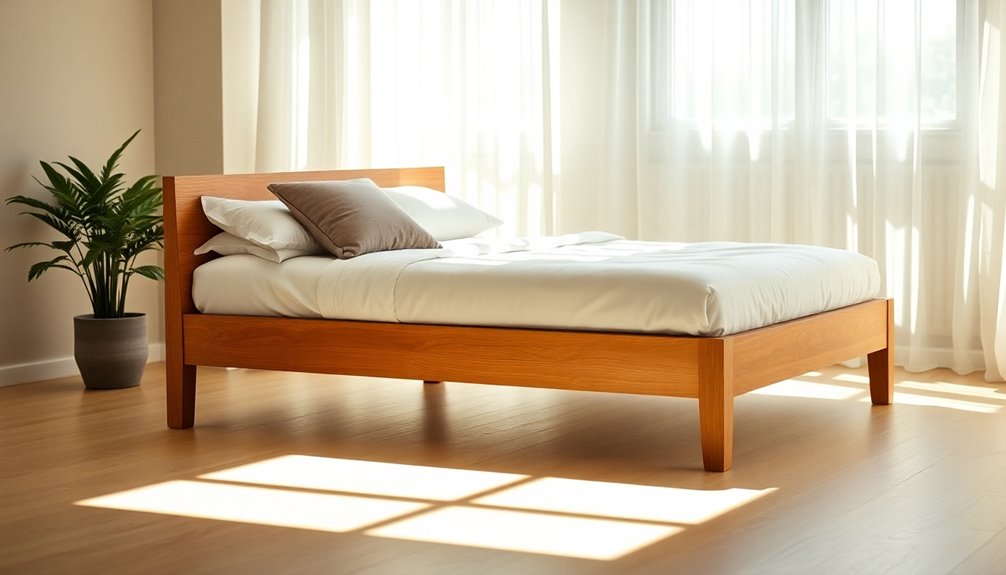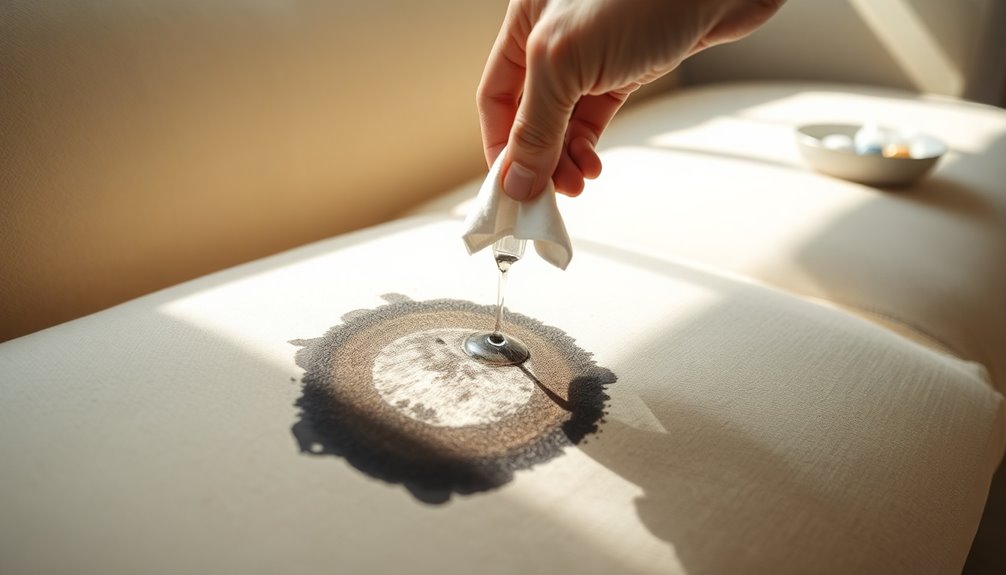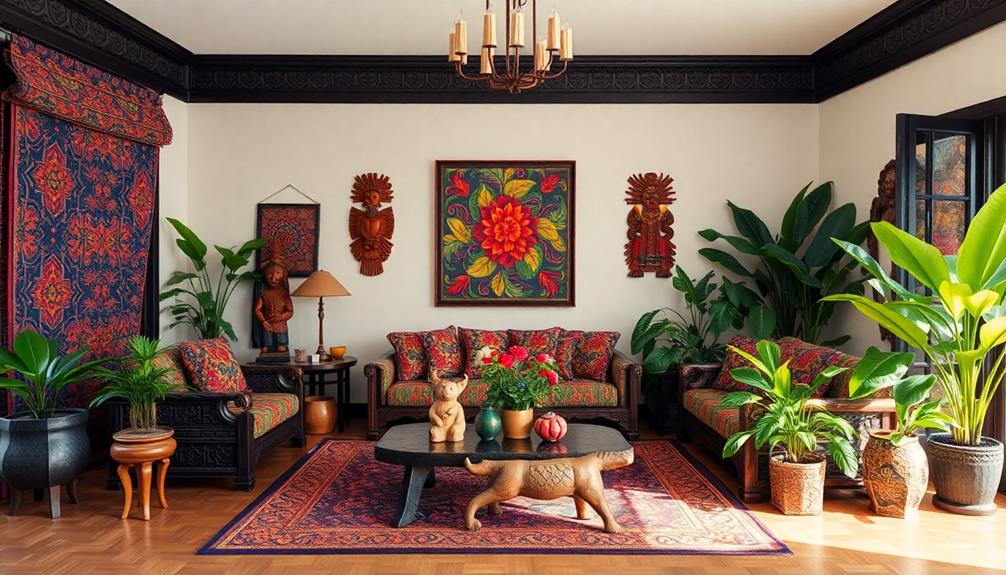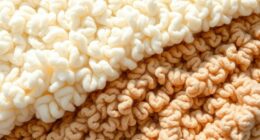Covering your sofa is a smart move to refresh its look and protect it. Start by choosing a fabric that resists fading and wear, like microfiber or tightly woven synthetics. You can personalize it further with colorful blankets or slipcovers that match your decor. Don't forget to regularly rotate and fluff your cushions to maintain their shape. When storing seasonal covers, use breathable bags and keep them away from sunlight to prevent damage. This approach not only enhances aesthetics but also extends your sofa's lifespan. Stick around; there's much more to explore about keeping your furniture in top shape!
Key Takeaways
- Choose a fitted slipcover or throw blanket that matches your decor and protects against wear and tear, enhancing sofa longevity.
- Use fabric protectant spray on slipcovers every 6 to 12 months to maintain a fresh appearance and prevent staining.
- Ensure proper cleaning techniques are applied based on your sofa's material, such as using upholstery cleaners for fabric or specialized products for leather.
- Rotate and fluff cushions regularly to maintain their shape and structure, while also using protective sprays for added durability.
- For seasonal storage, use breathable bags and stuff cushions with acid-free tissue paper to preserve their shape.
Introduction
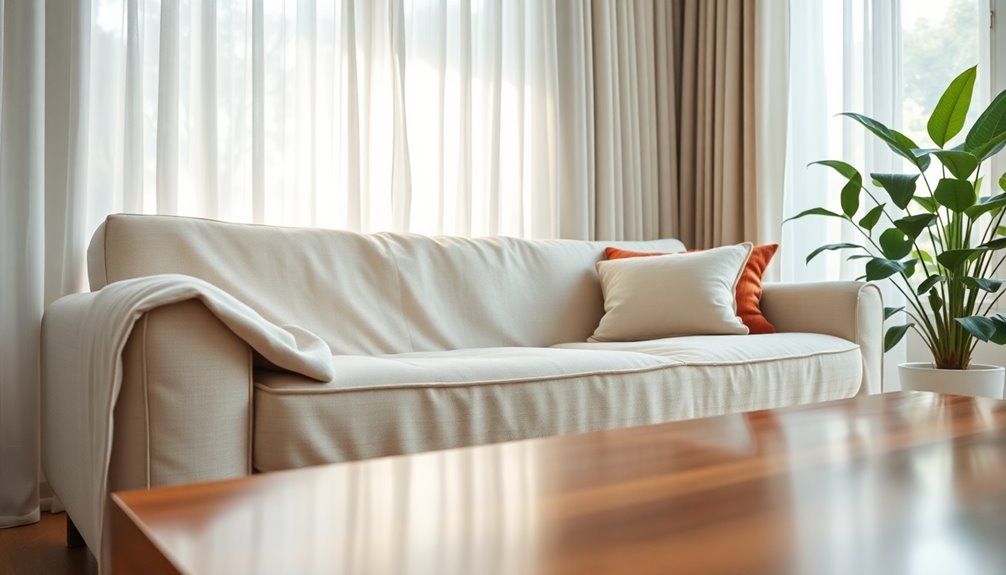
Keeping your sofa looking great requires regular care and attention. You'll want to incorporate weekly vacuuming and dusting, along with fabric-specific cleaning techniques to maintain its appearance. And if you ever face a red wine spill, knowing how to tackle it quickly can save your sofa from lasting damage. Additionally, using a vacuum with HEPA filters can help eliminate allergens and dust, ensuring your sofa remains clean and inviting.
Weekly Vacuuming and Dusting
To maintain your sofa's appearance and hygiene, weekly vacuuming and dusting are essential practices. Regular vacuuming helps remove dust, pet hair, and allergens, promoting a healthier living environment. Use a vacuum with an upholstery attachment, ensuring it effectively cleans fabric surfaces and crevices without damaging them. This step is crucial in keeping your sofa looking fresh.
After vacuuming, don't forget about dusting. A microfiber cloth is ideal for eliminating surface dust, preventing it from settling into the fabric fibers. This simple task can significantly improve the overall cleanliness of your sofa, making it more inviting.
Incorporating both weekly vacuuming and dusting into your routine can extend the life of your sofa. By preventing dust and allergens from building up, you protect the materials from wear and tear over time. Additionally, if you notice any stains or spots, following up your vacuuming with a fabric-safe upholstery cleaner can help maintain your sofa's overall appearance. This proactive approach ensures your sofa remains a comfortable and stylish centerpiece in your living space for years to come.
Fabric-Specific Cleaning Techniques
Regular maintenance like vacuuming and dusting sets the stage for deeper cleaning techniques tailored to your sofa's fabric. For cotton and linen sofas, you can spot clean using a mixture of water and mild detergent. Just steer clear of harsh chemicals, as they can damage the fabric fibers. If your sofa cover is made from synthetic fabrics like polyester, a solution of warm water and vinegar works wonders for stain removal without risking discoloration.
Velvet upholstery requires a gentle touch; use a soft-bristled brush to lift dirt and maintain its plush appearance. For deeper cleaning, steam cleaning is your best bet. Leather sofas need specialized leather cleaner and conditioner to prevent cracking, so avoid excessive moisture that can lead to damage.
When dealing with microfiber furniture, a mixture of rubbing alcohol and water helps with spot cleaning, evaporating quickly to prevent water stains. By understanding these fabric-specific cleaning techniques, you can keep your sofa looking fresh and ready for use, ensuring its longevity and comfort.
Tackling Red Wine Spills
When red wine spills on your sofa, quick action is crucial to prevent a lasting stain. Start by grabbing a clean, dry cloth and gently blot the stain to absorb as much liquid as possible. Avoid rubbing, as this can spread the stain further. Next, sprinkle salt or baking soda over the spill; these absorbents will help lift the wine. Let it sit for several minutes before vacuuming it away.
For a more thorough cleaning, mix equal parts white vinegar and water. Apply this solution to the stain with a cloth and blot until the stain lifts. If you're dealing with a fabric sofa and the stain persists, you might want to try a mixture of dish soap and hydrogen peroxide. However, always test it on an inconspicuous area first to prevent discoloration.
Finally, check your sofa's manufacturer cleaning instructions before applying any solutions to ensure you're protecting your cover. Being proactive and using these techniques can help keep your sofa looking fresh and free from red wine stains.
Avoiding Direct Sunlight Exposure

To keep your sofa looking fresh, it's crucial to protect it from direct sunlight. You can choose scratch-resistant fabrics and swaddle your sofa with colorful blankets for added flair and protection. Additionally, using a fabric protectant spray can help guard against sun damage, ensuring your upholstery stays vibrant for longer.
Scratch-Resistant Fabric Choices
Choosing the right fabric for your sofa can make all the difference in its longevity and appearance. Opting for scratch-resistant fabrics like microfiber, denim, or tightly woven synthetic fibers significantly boosts your sofa's durability against everyday wear and tear. These materials withstand the rigors of daily life, especially in homes with pets or children.
When selecting fabrics, look for those with a high rub count—ideally above 15,000 double rubs. This rating indicates better resistance to abrasion, ensuring your sofa stays looking fresh longer. Additionally, remember to avoid direct sunlight exposure, as this can lead to fading and deterioration, particularly for fabrics like cotton or linen.
Regular maintenance, such as rotating and fluffing cushions, helps maintain the sofa's structure and appearance, enhancing the lifespan of your chosen scratch-resistant fabrics. You might also consider using protective sprays or treatments specifically designed for upholstery. These products add an extra layer of defense against scratches and stains, keeping your sofa in top condition. By making informed fabric choices and taking preventive measures, you can ensure your sofa remains a beautiful and durable centerpiece in your home.
Swaddle With Colorful Blankets
Swaddling your sofa with colorful blankets not only adds a pop of personality to your living space but also protects it from everyday wear and tear. Choose throw blankets made from soft, durable materials like cotton or wool to ensure comfort and longevity. These blankets act as couch covers, giving your furniture a fresh, new look while safeguarding against stains and spills.
To keep your sofa looking vibrant, avoid placing it in direct sunlight, as UV rays can cause the colors to fade over time. Instead, position your sofa in a way that minimizes sun exposure or use sheer curtains to filter the light.
Experiment with different patterns and textures by layering multiple blankets. This not only enhances visual appeal but also creates a cozy atmosphere. Regularly adjust and re-tuck the blankets to maintain their placement and ensure a neat finish, making your sofa a stylish focal point in your room. Additionally, incorporating unique decor elements can further enhance the overall aesthetic of your space, adding distinctive decor style that reflects your personal taste.
Incorporating colorful blankets is a simple yet effective way to refresh your space while keeping your sofa protected. So, get creative and enjoy the process of swaddling your sofa for ultimate comfort and style!
Using Fabric Protectant Spray
While colorful blankets offer a great way to protect your sofa, using a fabric protectant spray can enhance that protection even further. This spray creates a barrier against stains and spills, helping to extend the life of your sofa by preventing absorption into the fabric. To ensure effectiveness, it's crucial to choose a protectant compatible with your specific fabric type; otherwise, you may risk damaging your sofa.
When applying the fabric protectant spray, do so in a well-ventilated area and avoid direct sunlight. UV exposure can degrade the effectiveness of the protectant, making it less reliable. After application, allow the spray to dry completely, typically around 24 hours, to achieve optimal protection before using your sofa.
To maintain its protective qualities, regularly reapply the fabric protectant every 6 to 12 months, or as directed. This step is essential in keeping your sofa looking fresh and safeguarding it against wear and tear. If you've invested in sofa slipcovers, using a fabric protectant spray on them can further enhance their durability and maintain their appearance.
Cushion Replacement Techniques
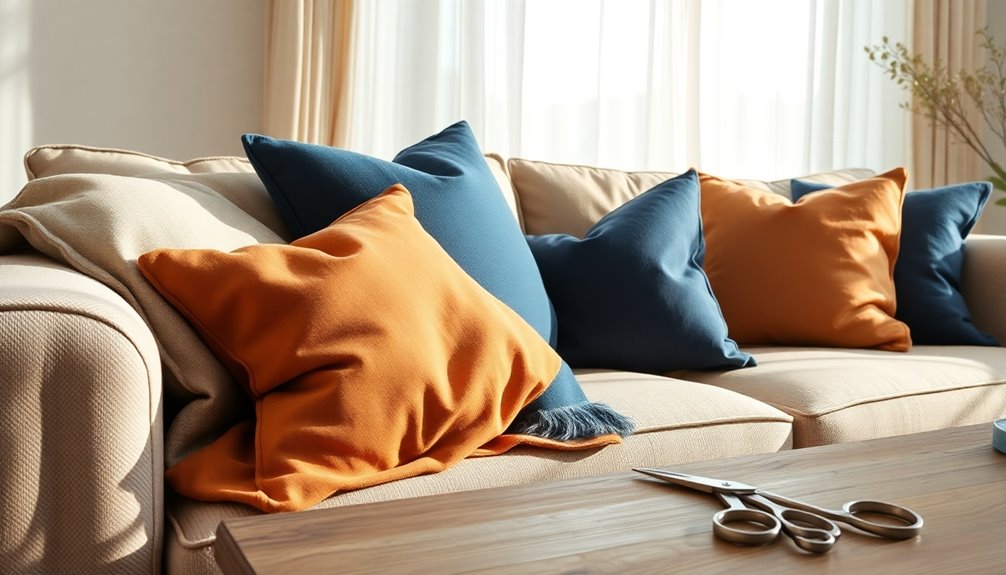
When it comes to rejuvenating your sofa, tackling cushion replacement techniques can make a big difference. You'll want to focus on repairing the support frame, upgrading cushion foam, and addressing any leather conditioning needs. These steps not only enhance comfort but also extend the life of your furniture.
Cushion Support Frame Repairs
To ensure your sofa cushions provide optimal support and comfort, you'll need to address any issues with the cushion support frame. Start by checking for sagging cushions. If they're sagging, consider replacing them with high-density foam that's at least 2-3 inches thick for better support. Next, reinforce the existing frame using plywood or L-brackets. This will secure the fabric and ensure that the base can adequately support the cushions you choose.
Don't forget about the webbing underneath. If it's worn out, replace it with new elastic or jute webbing to enhance the overall support system. Adding a layer of batting over the foam can also improve comfort, making your seating experience more inviting.
Regularly inspect the cushion support frame for any loose screws or damages. Tighten or replace them as necessary to maintain cushion stability and longevity. By following these repair techniques, you'll ensure your sofa not only looks great with new cushion covers but also provides the support you need for a comfortable seating experience.
Leather Conditioning and Repair
Maintaining your leather sofa goes hand in hand with ensuring its cushions are in top shape. Regularly using a high-quality leather conditioner every 6 to 12 months keeps the leather supple and prevents cracking. Before applying the conditioner, slightly heat the leather for better absorption.
If you notice minor scratches or scuffs, a leather repair kit can help. These kits usually include color-matching dye, filler, and sealant, making it easy to achieve a seamless fix.
When it comes to cushion replacement, opt for high-density foam, ideally 4 to 6 inches thick for standard seating comfort. If your cushion covers are worn out, carefully remove the old fabric and use it as a template to cut new fabric. Don't forget to leave extra for seams and tucking.
For a polished look, consider using couch covers that complement your decor while protecting your cushions. With these steps, you ensure your leather sofa remains comfortable and visually appealing, enhancing your living space for years to come. In addition to using stylish couch covers, it’s essential to know how to clean leather sofa surfaces properly to maintain their luster and durability. Regularly dusting and conditioning the leather can prevent cracks and fading, keeping your seating area looking fresh. By following these care tips, you not only preserve the beauty of your furniture but also create a more inviting atmosphere in your home.
Cushion Foam Upgrades
Upgrading your sofa's cushion foam can dramatically enhance both comfort and support. If you're looking for a DIY sofa project, replacing worn-out foam is a great place to start. High-density foam is recommended for a firmer feel and long-lasting support, and it comes in various thicknesses from 2 to 6 inches.
To get started, remove the old cushion and measure its dimensions accurately—length, width, and height. Don't forget to add an extra inch for a snug fit within the couch covers. You can find upholstery foam at craft stores or online, typically priced from $10 to $30 per yard based on quality and density.
For a personalized touch, consider layering different types of foam. For instance, placing a softer foam on top of a firmer base can create a customized comfort level tailored to your preferences. Remember, it's a good idea to replace your cushion foam every 3 to 5 years to maintain not just comfort but also the aesthetic appeal of your sofa. This simple upgrade can breathe new life into your living space.
Personalized Fabric Patterns
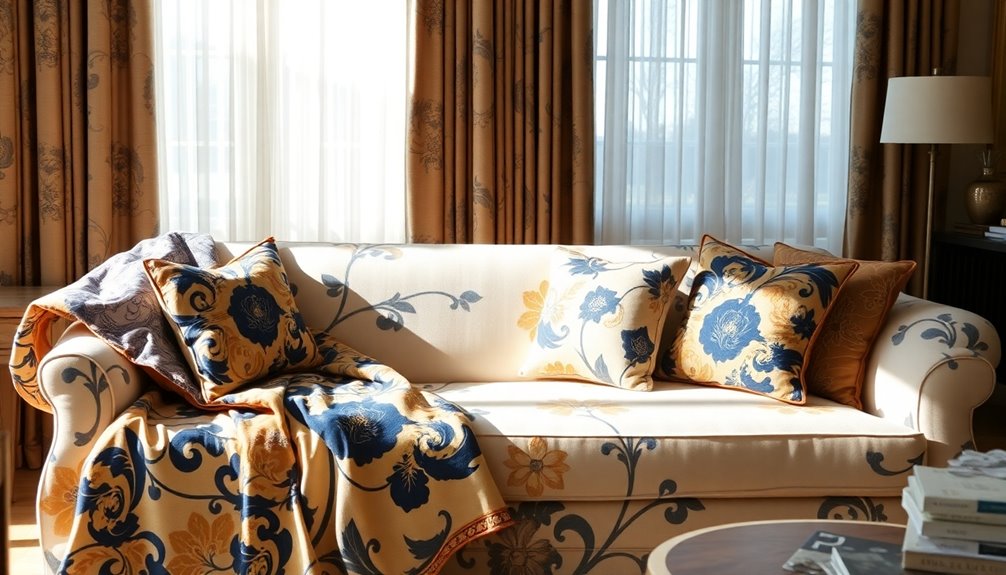
Personalized fabric patterns bring a sense of individuality and creativity to your sofa, allowing you to express your unique style. With options ranging from floral to geometric prints, you can easily find designs that enhance your living space's overall decor. When choosing personalized fabric patterns, think about how the scale of the design affects your sofa's appearance. Larger patterns might overwhelm smaller spaces, while smaller patterns may get lost on larger sofas.
You'll find many retailers offering the ability to create custom prints, enabling you to select colors and designs that match your existing decor or even replicate sentimental patterns from cherished items. This way, your sofa can become a true reflection of who you are.
Additionally, utilizing personalized fabric patterns not only revitalizes an old sofa but also adds a layer of protection. Unique designs can cleverly conceal stains and wear, giving your furniture a fresh, custom look. So, when you're ready to cover your sofa, consider how personalized fabric patterns can transform your space while showcasing your unique tastes and preferences.
Seasonal Fabric Storage Tips
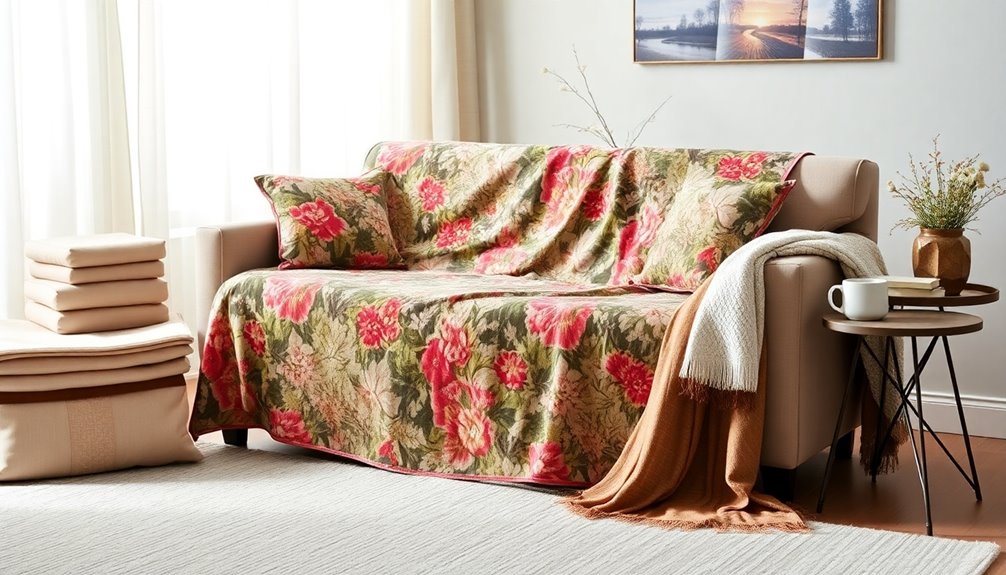
Seasonal fabric storage can be a game changer for keeping your sofa looking fresh and stylish throughout the year. To protect your seasonal fabrics, use breathable cotton or linen bags. These materials help prevent moisture buildup and keep mildew at bay. It's crucial to store your fabrics in a cool, dry place, away from direct sunlight, to avoid fading and degradation.
When packing your cushions, stuff them with acid-free tissue paper. This supports their shape and prevents creases over time. For more efficient storage, consider using vacuum-sealed bags. Just make sure your fabrics are completely dry before sealing them to prevent mold growth.
Label your storage containers clearly with the contents and the corresponding season. This simple step streamlines the process of swapping out fabrics, making it easier to refresh your sofa when the seasons change. By following these tips, you'll keep your seasonal fabrics in great condition, ensuring they look fantastic every time they're in use. With proper storage, you can enjoy a stylish, comfortable sofa all year round without worrying about wear and tear.
Conclusion
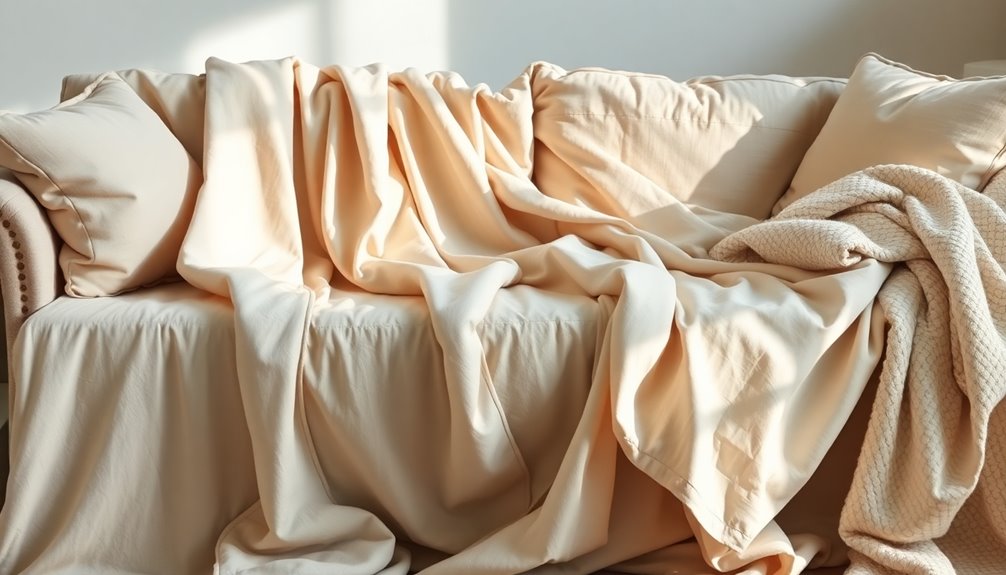
Covering your sofa is a smart investment in both style and durability. By choosing the right couch cover, you can enhance your sofa's appearance, protect it from stains, and extend its lifespan. Whether you opt for a DIY slipcover, a no-sew option, or a store-bought solution, you can easily find a method that fits your skill level and aesthetic needs. Just remember, accurate measurements are crucial to ensure a proper fit, so take note of your sofa's size and cushion count.
Regular maintenance, like washing and adjusting your cover, will keep it looking fresh and suitable for seasonal decor changes. If you're looking for a budget-friendly option, creative techniques using drop cloths or blankets can transform your sofa into a stylish new piece without the need for costly reupholstery.
Frequently Asked Questions
How Can I Cover My Couch Without a Couch Cover?
You can easily cover your couch without a traditional cover by using king-sized sheets or blankets. They're cost-effective and simple to clean. For a casual look, drape large drop cloths and secure them with a staple gun if needed. Mismatched throw blankets can add color and style, while fabric remnants or old quilts create a unique patchwork aesthetic. Use safety pins and creative folding to keep everything in place, giving your couch a fresh appearance.
Can You Reupholster a Couch Yourself?
Yes, you can definitely reupholster a couch yourself! It's a rewarding project that lets you customize your furniture. You'll need some basic sewing skills, tools like a staple gun and seam ripper, and new fabric to get started. The process might take a few hours or even days, depending on your couch's complexity. With plenty of online guides, you'll find step-by-step instructions to help you along the way. Enjoy the transformation!
How Do You Cover a Sofa?
When you want to cover your sofa, start by choosing your material. You can opt for pre-made slipcovers, or get creative with DIY solutions using fabric or blankets. Measure your sofa carefully to ensure a good fit, cutting the fabric generously to tuck in. Secure the cover with techniques like staples or Velcro. Don't forget to wash your fabric first to get rid of chemicals, and maintain it regularly for lasting quality.
Can You Use a Comforter as a Couch Cover?
Absolutely, you can use a comforter as a couch cover! It offers a soft and cozy look while protecting your sofa. Just make sure the comforter is large enough; a king-sized one usually covers most couches well. Plus, it's a budget-friendly option if you've got an old comforter lying around. Choose a color or pattern that matches your décor, and use blanket clips to keep it secure and in place.

